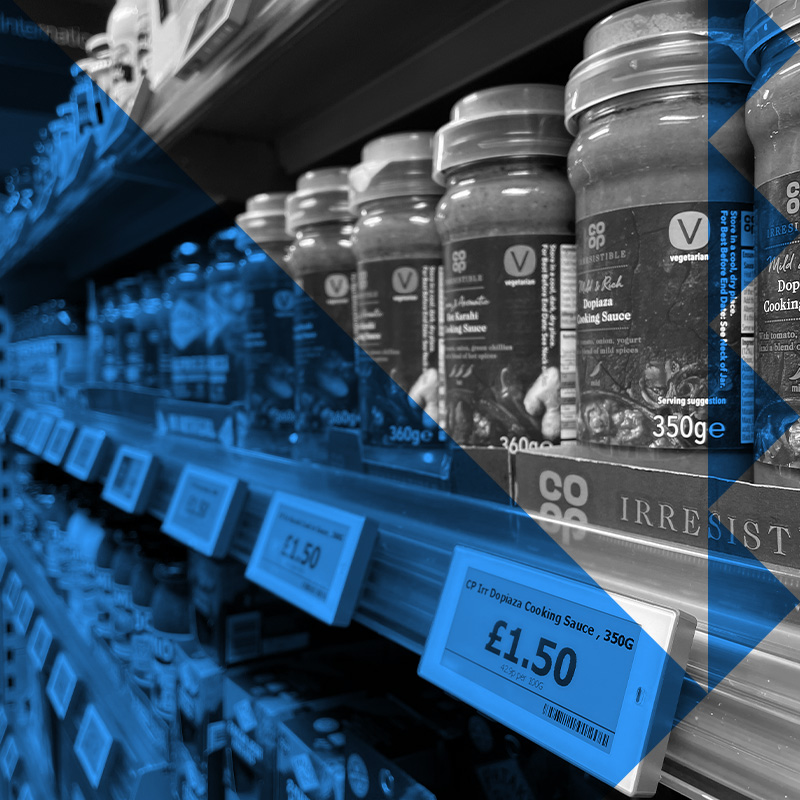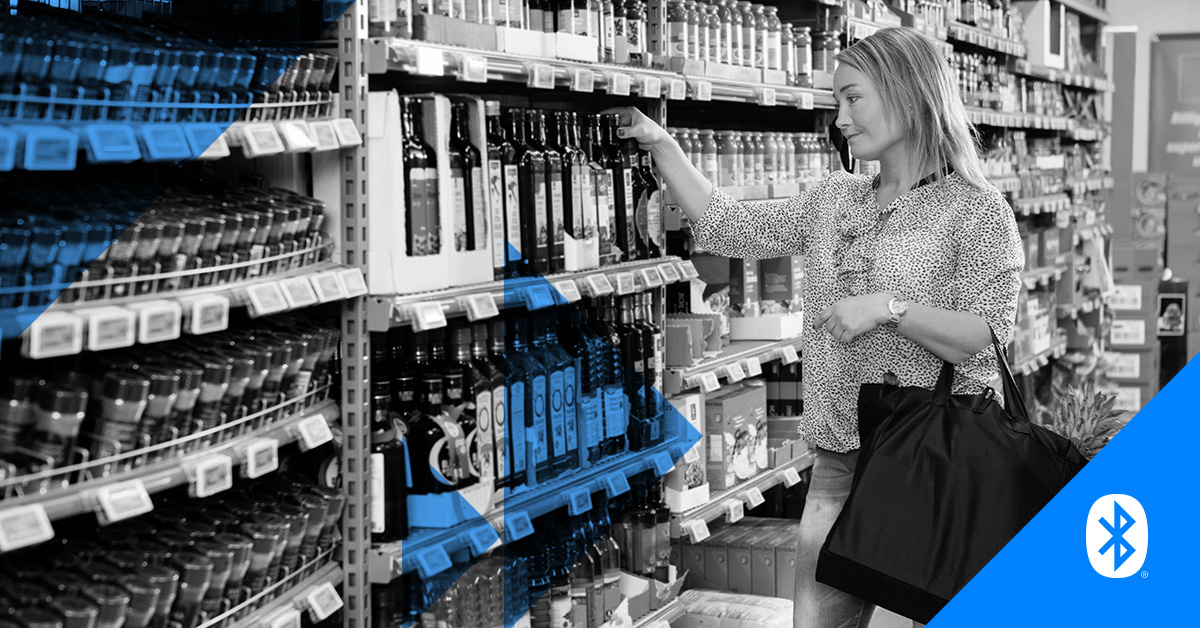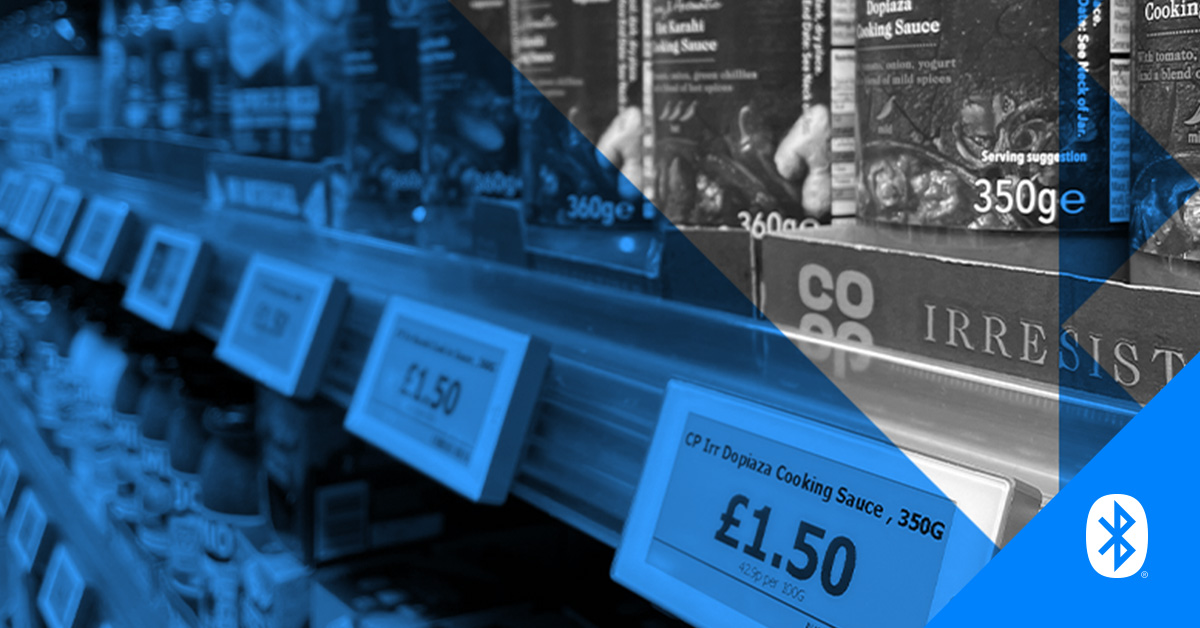SES-imagotag Outlines What You Need to Know About Electronic Shelf LabelsSES-imagotagが解説する、電子棚札(ESL)について知っておくべきこと
|
SES-imagotag (now VusionGroup) provides cutting-edge technology and solutions, including innovative electronic shelf labeling (ESL) solutions, offering state-of-the-art and fully digital price labels to retailers and industrial companies. Their product portfolio includes a wide range of ESL solutions based on various wireless communication technologies, such as Bluetooth® technology, NFC, and integrated IoT and digital signage solutions.
I recently spoke with Matthias Buch, SES-imagotag director of IoT product management, to gain insight into the ESL market and the impact the new Bluetooth standard will have on the industry.
Q&A With Matthias Buch From SES-imagotag

What has been your involvement in creating a wireless ESL standard inside the Bluetooth Special Interest Group (SIG)?
SES-imagotag has been heavily involved in defining and contributing to the new Bluetooth® standard that supports ESLs as its main use case. SES-imagotag was a main contributor and co-chair to the Bluetooth ESL Working Group and has brought its R&D team’s expertise and know-how in retail IoT applications together to the creation of this new standard specification.
What is your company’s experience with ESLs?
SES-imagotag is a global innovator in smart digital labels and IoT solutions for physical retail, serving over 350 large retailers around the world in Europe, Asia, and America. We have more than 25 years of experience in the ESL market and have installed over 350 million digital price labels.
SES-imagotag developed the VUSION Retail IoT platform to help retailers transform their physical stores into high-value digital assets that are more automated, data-driven, and connected in real time to suppliers and consumers. ESL solutions like ours improve pricing agility, accuracy, and integrity; they enable omnichannel synchronization of prices, product information, and marketing content; and they increase the productivity of shelf replenishment and in-store picking for online orders.
ESL solutions significantly improve employee satisfaction by freeing up time from cumbersome, low-value-added tasks and allows them to focus on customer service and merchandising duties. ESL solutions connect shelves to the cloud, providing accurate, real-time information on product availability and location, allowing for reduced inventory, out-of-stock, and waste, as well as improved on-shelf availability and merchandising compliance. These solutions provide consumers with better product, nutritional, and traceability information at the shelf and enable a frictionless in-store shopping experience with features such as product search, pathfinding, and cashier-less scan and pay.
What are the requirements for a successful ESL in a retail market?
High Quality and Durability are essential to ensuring ESLs can withstand the demands of a busy retail environment. They should be able to function consistently without requiring frequent maintenance or battery replacements.
Accuracy is of the utmost importance, as it is critical that the information displayed on ESLs is accurate and up to date. Any discrepancies in pricing or product information can result in customer dissatisfaction and lost sales.
Flexibility is also crucial, as retailers require a solution that is flexible, easily scalable, and able to integrate with existing systems.
Why is it important to have a standard-based technology for ESLs?
Electronic shelf labels (ESL) are becoming increasingly popular in the retail industry.
Electronic shelf labels (ESL) are becoming increasingly popular in the retail industry, as acknowledged by the adoption pace picking up in markets such as North America. Indeed, ESLs provide many benefits to retailers, such as reducing labor costs and errors associated with manual price labeling, improving inventory management, and enabling dynamic pricing strategies.
As ESLs enter a more mature phase and markets move from early adopters to mass adoption, standardization will naturally occur as it might help customers capitalize on their infrastructure products for other devices, such as sensors, anti-theft protections, and many more. As such, we’ve added support for the new Bluetooth® Low Energy (LE) standard to our VUSION Retail IoT platform to ensure we meet our customers where they are in their ESL rollouts.
Recently, SES-imagotag’s Bluetooth LE integration was chosen for the largest ESL rollout in history with a major US retailer, totaling 60 Million ESLs across 500 locations.
What are some of the major market challenges with ESLs, and how does Bluetooth technology help you meet them?
Communication between diverse IoT devices within a store can be challenging when not using the same protocol. Bluetooth® LE facilitates the integration with third-party Bluetooth LE-enabled products (sensors/existing Bluetooth enabled devices) and enables entirely connected stores.
The cost of a dedicated infrastructure can be another challenge. Rollouts can depend on proprietary communication protocols, calling for additional infrastructure hardware and costs to support a move to ESL for retailers. SES-imagotag already offers infraless deployments with select access points partners, and the addition of Bluetooth Low Energy (LE) integration into the portfolio allows for a similar approach, reusing an existing Bluetooth LE-compatible infrastructure to lower the cost of entry of rolling out ESLs for smaller retailers.
Similarly, based on heavy costs for a full ESL deployment, some markets might not be ready to adopt ESLs at scale. Bluetooth LE might help increase and quicken smart label adoption in these regions.
Can you talk about the benefits Bluetooth ESLs bring to retail and industrial markets?

Bluetooth® ESLs bring similar benefits to retailers as HF or radio-based ESLs, i.e., pricing automation, centrally managed price tickets and updates, and operational efficiency throughout various store processes.
In addition, Bluetooth technology unlocks interesting avenues to explore, such as easier integration with third-party sensors and devices that could be used for proximity-based interactions through Bluetooth compatible smartphones. With energy harvesting capabilities, we could also imagine having battery-less devices or devices with a longer battery life. Lastly, we could mention the positioning capabilities that can help retailers get more efficient at in-store picking and more granular on how shoppers navigate and engage with products.
Can you provide some examples of how Bluetooth ESLs will improve operational efficiencies?
With Bluetooth® ESLs, real-time automation will be enhanced, resulting in increased responsiveness, accuracy, and quality of pricing execution.
With Bluetooth® ESLs, real-time automation will be enhanced, resulting in increased responsiveness, accuracy, and quality of pricing execution at the store or retail chain level.
First, Bluetooth ESLs eliminate the need for time-consuming and error-prone manual updates. This allows associates to focus on more important tasks.
Second, Bluetooth ESLs simplify inventory management by also providing real-time updates on pricing, availability, and other important information. This allows retailers to automate price changes, track inventory levels, and avoid errors, resulting in greater accuracy, cost savings, and better control of inventory levels.
Finally, providing accurate, real-time information on product availability and location also reduces inventory stock-outs and waste and improves shelf availability and merchandising compliance.
Can Bluetooth ESLs be used in environments with high levels of interference, such as retail stores with a lot of electronic equipment?

Yes, Bluetooth® ESLs can be used in environments with high levels of interference, including retail stores with a lot of electronic equipment. This is because Bluetooth technology uses frequency hopping to avoid interference from other wireless devices.
SES-imagotag conducted tests in real-life retail environments to demonstrate the reliability of their Bluetooth enabled ESLs. These tests have been conducted in busy retail environments with high levels of electromagnetic interference, such as supermarkets with multiple Wi-Fi networks, cellular networks, and other electronic devices. The results showed that Bluetooth technology was able to provide reliable communication between the ESLs and the central server with no interference issues reported.
What is the expected battery life of Bluetooth ESLs, and how does it compare to other technologies?
The expected battery life of Bluetooth® ESLs depends on several factors, such as the frequency of updates, display size, and the type of battery used. Typically, an ESL’s battery power lasts several years, depending on the usage and conditions. This is comparable to other wireless technologies, such as Zigbee and Wi-Fi. However, Bluetooth LE used in Bluetooth ESLs is designed to be power efficient, which helps to extend battery life.
What is the cost of implementing Bluetooth ESLs compared to other wireless communication technologies?
The Bluetooth® 5.4 Specification is an important advancement in the world of wireless communication.
The answer to this question varies greatly from one situation to the next. In a typical ESL deployment using a proprietary protocol, retailers must account for investing in the ESL plus supporting connectivity infrastructure. In the case of a Bluetooth® ESL deployment, an infraless solution, i.e., using existing connectivity infrastructure, is an option that could help lower the initial hardware investment.
In other words, when the technology matures, Bluetooth ESL deployments should be similar in cost as infraless deployments, such as SES-imagotag’s, using integrations with infrastructure partners to remove the need for dedicated access points.
Do you have any plans to support the recently released Bluetooth Specification 5.4 in your future product offerings?
As a global leader in digital solutions for physical retail, we are constantly evaluating and researching the latest technological advancements to improve our products and services. The new Periodic Advertising with Responses (PAwR) feature and the new Bluetooth® ESL profile are important advancements in the world of wireless communication, which we plan to fully explore for future product offerings.
Our R&D and product development teams are actively investigating the capabilities and benefits of the new PAwR feature and the new Bluetooth ESL profile, and we are exploring how it could enhance the functionality and performance of our existing products or enable us to launch new products.
SES-imagotag は、最新の完全デジタルな棚札を小売・産業向けに実現した革新的な電子棚札(ESL)ソリューションをはじめ、最先端の技術やソリューションを提供しています。Bluetooth®︎やNFCなどの無線通信技術に基づく幅広い種類のESLソリューションのほか、統合IoTとデジタルサイネージのソリューションも取り揃えています。
は、最新の完全デジタルな棚札を小売・産業向けに実現した革新的な電子棚札(ESL)ソリューションをはじめ、最先端の技術やソリューションを提供しています。Bluetooth®︎やNFCなどの無線通信技術に基づく幅広い種類のESLソリューションのほか、統合IoTとデジタルサイネージのソリューションも取り揃えています。
先日、SES-imagotagのIoTプロダクトマネジメントディレクター、マティアス・ブッフ(Matthias Buch)氏とお話しする機会があり、ESL市場について、また新しいBluetooth規格が業界に及ぼす影響について伺いました。
SES-imagotagのマティアス・ブッフ氏とのQ&A
御社はどのような形でBluetooth SIG(Special Interest Group)におけるワイヤレスESL規格の策定に関わられましたか。
SES-imagotagは、ESLを主なユースケースとする新しいBluetooth®︎規格の策定に深く関わり、貢献してきました。当社は主要コントリビューターとして、またBluetooth ESLワーキンググループの共同委員長として、当社のR&DチームのリテールIoTアプリケーションに関する専門知識とノウハウをまとめ、この新規格の仕様策定のために提供しました。
ESLに関する御社の経験はどのようなものでしょうか。
SES-imagotagはスマートデジタルラベル及び実店舗IoTソリューション分野におけるグローバルイノベーターであり、ヨーロッパ、アジア、米国をはじめ世界中で350社を超える大手小売企業にご利用いただいています。25年を超えるESL市場における経験と、3億5000万枚を超える デジタル値札の設置実績があります。
当社では「VUSIONリテールIoT」というプラットフォームも開発しています。これは、実店舗の自動化とデータドリブン化を推進し、サプライヤーや消費者とリアルタイムに接続できるようにすることで、実店舗が高価値なデジタル資産に生まれ変わるよう、小売業者を支援するためのプラットフォームです。当社が提供するようなESLソリューションがあれば、価格設定の迅速性・正確性・整合性が向上します。複数のチャネル間での価格・商品情報・マーケティングコンテンツの同期も可能です。また、商品棚の補充やオンライン注文に対する店舗内でのピッキング作業の効率も向上します。
ESLソリューションによって、従業員は手間がかかり付加価値の低い作業から解放され、接客・販売業務に集中できるため、従業員満足度も大きく向上します。また、ESLによって商品棚の情報がクラウド接続されるため、商品の在庫と所在に関する正確な情報をリアルタイムで把握でき、在庫削減、品切れ防止、廃棄処分の低減、さらには商品棚の充填状況の改善や販促活動におけるコンプライアンス向上にもつながります。消費者に対しては、商品棚で提供する商品の製品情報・栄養情報・トレーサビリティ情報を拡充し、商品検索や店内案内機能、レジに並ばずスキャンして支払いが行える機能などを通じて、店舗での快適な買い物体験を実現します。
小売市場で成功するESLに必要な要件とはどのようなものでしょうか。
高い品質と耐久性が、第一に挙げられます。これは、時間に追われ、すべきことの多い小売現場の要求に応じるためには必須の条件です。頻繁な保守やバッテリー交換を必要とせず、安定して機能できる必要があります。
正確性は最も重要な要件と言えます。なぜなら、ESLに表示される情報は正確かつ最新である必要があるためです。いかなる価格や商品情報の齟齬も、顧客の不満を招き、売上減少につながりかねません。
柔軟性もまた、非常に重要です。小売業では、柔軟性があり、容易に拡張でき、既存システムとの統合が可能なソリューションが求められます。
なぜ、ESL用に標準規格ベースの技術を策定することが重要なのでしょうか。
小売業でのESL普及の進展は、北米市場などにおける導入ペースの加速からも明らかです。実際、ESLは、人件費や人手による値札作業で発生するミスを削減し、在庫管理を向上させ、動的な価格戦略を可能にするなど、小売業にいくつもの利点をもたらします。
ESLがより成熟した段階に入り、市場がアーリーアダプター(早期導入者)から一般普及へと移行すると、標準化の流れは自然と起きるでしょう。既存のインフラを、センサーや盗難防止装置などさまざまな製品にも活用できる可能性があるためです。このため、当社のお客様のあらゆるESL導入段階に確実に対応できるよう、VUSIONリテールIoTプラットフォームに新しい Bluetooth®︎ LE規格への対応を追加しました。
最近では、SES-imagotagのBluetooth LEを使用した統合システムが、米国の大手小売企業500拠点で総計6000万枚のESLという史上最大規模のESL設置のため選ばれました。
ESL市場には主にどのような課題がありますか。またBluetooth技術は、その課題への対処にどのように役立っていますか。
同じプロトコルを使用していない場合、店舗内の各種IoTデバイス間の通信が困難になる可能性があります。Bluetooth®︎ LEでは、サードパーティのBluetooth LE対応製品(センサー/既存のBluetooth対応デバイス)を統合しやすく、店舗全体として通信接続可能な状態を実現できます。
別の課題は専用インフラのコストです。導入は独自の通信プロトコルに縛られる場合があり、小売企業がESLを導入する際には追加でインフラ用のハードウェアや費用が必要になることが考えられます。SES-imagotagでは、アクセスポイントの優良パートナー各社とともにインフラレスでの導入にも 既に対応しています。このたび当社のポートフォリオに加わったBluetooth LEの統合によっても同様のアプローチが可能になるため、既存のBluetooth LE対応インフラを再利用することにより、比較的小規模な小売企業がESLを展開する際の初期導入コストを抑えられます。
同様に、ESLの全面導入に必要な多額のコストを考えると、大規模な採用にはまだ早い市場もあるかもしれません。このような地域では、Bluetooth LEがスマートラベル導入の拡大・加速に役立つ可能性があります。
 Bluetooth ESLが小売業や産業市場にもたらすメリットにはどのようなものがありますか。
Bluetooth ESLが小売業や産業市場にもたらすメリットにはどのようなものがありますか。
Bluetooth®︎ ESLは、小売業ではHFまたは無線ベースのESLと同様に、価格設定の自動化、値札及びその更新の集中管理、各種店舗内業務の効率向上といったメリットをもたらします。
加えて、Bluetooth技術によって興味深い可能性を探ることも可能になります。たとえば、Bluetooth対応のスマートフォンを介した近接通信に使用できるサードパーティのセンサーやデバイスの統合がより容易になります。また、環境発電機能を使用すれば、バッテリーを使用しないデバイスや、より長いバッテリー寿命を持つデバイスも構想できます。測位機能についても言えるでしょう。この機能により、店舗内でのピッキング作業の効率向上や、買い物客をいかに案内し、商品と関わりを持ってもらうかについて、より緻密に把握することができます。
Bluetooth ESLによる業務効率向上にはどのような例がありますか。
Bluetooth®︎ ESLを用いることにより、リアルタイムでの自動化を強化できるため、応答性、正確性及び価格設定の実行品質が、店舗または小売りチェーンレベルで向上します。
まず、Bluetooth ESLによって、時間がかかる上にミスを起こしやすい手作業での更新の必要がなくなります。これにより、従業員はより重要な業務に集中できるようになります。
次に、Bluetooth ESLは設定価格や在庫などの重要情報についてリアルタイムに情報提供することにより、在庫管理を簡素化します。これによって小売業者は、価格変更の自動化、在庫レベルの追跡、ミスの防止ができるため、正確性の向上、コスト節約、より良い在庫レベルのコントロールがもたらされます。
最後に、商品の在庫と所在に関する正確かつリアルタイムの情報を提供することにより、在庫切れ・廃棄処分を削減でき、商品棚の充填状況や販売促進のコンプライアンスも向上します。
 Bluetooth ESLは、電子機器の多い店舗など、干渉の多い環境でも使用できますか。
Bluetooth ESLは、電子機器の多い店舗など、干渉の多い環境でも使用できますか。
はい、Bluetooth®︎ ESLは電子機器の多い小売店舗など、干渉の多い環境でも使用できます。これはBluetooth技術が、他のワイヤレスデバイスからの干渉を避けるために周波数ホッピングを使用していることに理由があります。
SES-imagotagでは実際の小売現場で試験を実施し、当社のBluetooth対応ESLの信頼性を実証しました。試験は、複数のWi-Fiネットワーク、携帯電話ネットワーク、その他の電子機器が混在するスーパーマーケットなどの、高い電磁干渉を伴う、活動量の多い小売環境で行われました。試験によって示されたのは、Bluetooth技術によって各ESLと中央のサーバー間で信頼性の高い通信が実現できるという結果であり、干渉の問題は報告されませんでした。
Bluetooth ESLの推定バッテリー寿命はどの程度でしょうか。他の技術との比較ではいかがですか。
Bluetooth®︎ ESLの推定バッテリー寿命は更新頻度、ディスプレイの大きさ、使用するバッテリーの種類など、いくつかの要素によって決まります。一般にESLのバッテリー寿命は数年で、稼動状況や条件によって左右されます。この長さはZigbeeやWi-Fiなど他のワイヤレス技術でも同等です。しかし、Bluetooth ESLで使用されるBluetooth LEは高い電力効率を実現するよう設計されており、バッテリーの長寿命化に役立ちます。
他の無線通信技術に比べ、Bluetooth ESLの導入コストはどの程度でしょう。
これは、状況によって大きく異なる可能性があります。独自プロトコルを使用する場合の一般的なESLの導入では、ESLのコストに加え、それを支える通信インフラにも投資する必要があります。Bluetooth®︎ ESLの導入の場合は、インフラレス、すなわち既存の通信インフラを利用して行われるため、設備投資に必要な初期費用を下げられる可能性があります。
つまり、技術が十分に成熟した際には、Bluetooth ESLの導入はインフラレスと同様のコストが実現するはずです。すなわちSES-imagotagが行うような、インフラパートナーとの統合により専用のアクセスポイントを必要としない導入と同等のコストです。
先日公開されたBluetooth Core 5.4に今後対応していく予定はありますか。
実店舗向けデジタルソリューションのグローバルリーダーとして、当社は製品やサービスを改良するために常に最新の技術的進歩を評価・調査しています。新しいPAwR(レスポンス付き定期アドバタイズ)機能とBluetooth®︎ ESLプロファイルは、無線通信の世界において重要な進歩であり、当社の今後の製品・サービスのためにそのあらゆる可能性を探っていく予定です。
現在、当社のR&D並びに製品開発チームは、新しいPAwR機能とBluetooth ESLプロファイルの能力とメリットに関する活発な調査を進めています。それによっていかに現行製品の機能や性能を向上させ、新製品開発につながるかを検討しています。